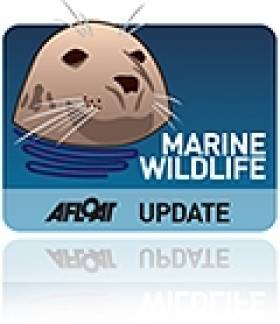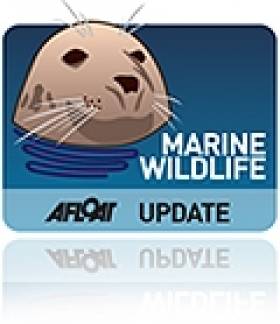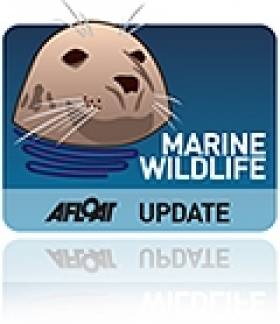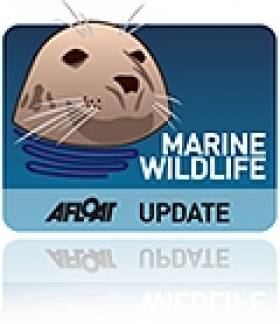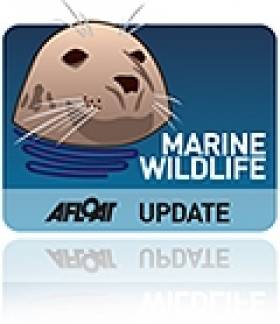Displaying items by tag: grey seal
'Sammy the Seal' Steals the Show With Ship-Side Survelliance
#CoastalNotes - During Afloat's visit to Wicklow Port this day last week, seemingly Sammy the Seal made a fleeting appearance when alongside a departing cargoship, writes Jehan Ashmore.
The departure that afternoon of Burhou-I involved the curious 'Sammy' or a fellow companion? make for inspection as the cargohip eased off slowly from the Packet Quay. On the next attempt to take a further zoomed-in photo, the seal slipped underneath the calm waters within Wicklow harbour.
Sammy the Seal has became something of a local celebrity in the town and beyond having gone 'viral' in recent years when footage showed the hungry grey seal 'visiting' the local fishmonger.
The presence of Sammy however, has become something of a nuisance, if you ask the staff of fishmongers, The Fishman on South Quay where local trawlers land catch. The fishmongers have to keep an eye on the mammal when crossing what can be a busy road before throwing him tasty fish scraps meals – one of three every day at high tide.
Returning to the port's commercial shipping activities, Burhou-I is engaged in the timber trade. The 674grt coaster is operated by Great Glen Shipping Co, Scotland from where round timber (logs) had been loaded for discharge in Wicklow Port.
Also in port this day last week was the cargoship's sister, Isis which this afternoon is bound for Wicklow Port having sailing from western Scotland. On board is more round timber having been loaded in Sandbanks, Holy Loch, located on part of the Cowal Peninsula along the Firth of Clyde.
Grey Seal Documentary Screening In Dublin This Weekend
#MarineWildlife - The Irish Film Institute (IFI) in Dublin is hosting special screenings of a new documentary that celebrates 100 years of the first wildlife species to be protected under law.
Lanugo: The Great Grey Seal/100 Years, 100 Voices marks the centenary of the UK's Grey Seals (Protection) Act 1914, with people from all walks of life, from fishermen to scientists, folklorists and more talking the legacy and future of the grey seal on the shores of Britain and Ireland.
"Among the first species threatened by biodiversity loss and most sensitive to climate change, they are as pertinent to our future today, as when their vulnerability was first recognised," say the team behind the film.
Produced by Brendan Rice, founder of the Irish Seal Sanctuary, and directed by filmmaker David Kavanagh, Lanugo will be screened at the IFI in Temple Bar this Saturday 13 December and next Wednesday 17 December at 10.30am (more details HERE).
All are welcome to the screenings but advance registration is required - contact [email protected].
Dead Seals Washed Up at Fethard-on-Sea
#MARINE WILDLIFE - The Gorey Guardian reports that the bodies of two grey seals were found washed up last week on Booley Bay beach, near Fethard-on-Sea in Co Wexford.
The two seal pups were found in an emaciated and malnourished state by a beach walker on 27 November.
According to Irish Whale and Dolphin Group chair Kevin MacCormick, dead seal strandings are not unusual at this time of year, particularly after stormy weather, and grey seals have an especially high mortality rate.
Tramua wounds and blood found on the seals were put down to predation by seabirds.
Seriously Ill Seal Pup Now In Recovery
#MARINE WILDLIFE - A harbour seal pup found in a serious condition in Balbriggan last week is new recovering in the care of the Irish Seal Sanctuary.
Colin, as he has been named by ISS volunteers, was discovered on Kings Beach suffering from blood loss and breathing problems, the Fingal Independent reports.
An ISS spokesperson remarked that it was "very unusual" to find harbour seal pups this late in the year, and in an area dominated by colonies of grey seals.
Thanks to medicine donated by the Dogs Aid veterinary clinic in north Dublin, Colin is now "making great progress" though full recovery will take some time.
The seal pup will remain in the care of the ISS until he is fit enough to be returned to Balbriggan for release.
Kerry Fishermen Want Seal Cull
Kerry fishermen are calling for a cull of the local grey seal population over claims that they eat up to 10kg of fish a day, The Irish Times reports on marine animals.
Fishermen along the Kerry coast are arguing the the seals are "over-protected", are too great in number and are posing a threat to salmon conservation, as well as depleting stocks of hake and pollock.
Concerns are on the rise that seals will be culled illegally if there is no official intervention on the matter. However, the National Parks and Wildlife Service has ruled out any action.
Locals in the Blasket Islands have claimed that more than 1,200 seals inhabit the area. Research by the Seal Track programme showed only 400 seals in the Blaskets in 2003, down over 40% from 1998 numbers.
The Irish Times has more on the story HERE.
Three Seals Set For Release This Weekend
The Irish Seal Sanctuary (ISS) is gearing up for three seal releases this coming weekend.
On Saturday 5 February ISS volunteers in tandem with the Dingle Wildlife and Seal Sanctuary will release Rupert and Rosie back into the wild at Beal Ban Beach in Ballyferriter, Co Kerry.
The two grey seal pups were rescued from the Dun Chaoin area last November within days of each other, the male pup with several injuries. Both now rehabilitated, it's expected they will rejoin the grey seal colony just off the Dingle Peninsula.
Then on Sunday 6 February the ISS will release another grey seal pup, Mary, from Kilpatrick Beach in Castletown, Co Wexford.
For more details on these releases visit www.irishsealsanctuary.ie



























